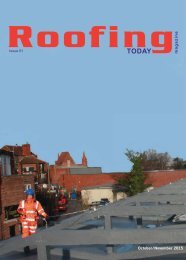Roofing
Roofing%20Today%20Issue%2065%20July%202016
Roofing%20Today%20Issue%2065%20July%202016
You also want an ePaper? Increase the reach of your titles
YUMPU automatically turns print PDFs into web optimized ePapers that Google loves.
A. Proctor feature<br />
Not all Underlays are<br />
Created Equal<br />
For years the debate on how to achieve a truly ventilation-free, cold pitched roof<br />
has continued across the construction industry. Now, reputable roofing contractors<br />
and leading housing developers such as Bellway, Bovis Homes and Crest<br />
Nicholson, backed by the NHBC, and independent industry research, have come to<br />
the realisation that some underlays perform at an exceptional level, providing a<br />
failsafe option, without the need for additional ventilation.<br />
Improved thermal and moisture performance of pitched roofs<br />
The A. Proctor Group developed Roofshield 20 years ago in response to problems<br />
caused by the UK’s demand for cold pitched roof construction, and the drive<br />
towards ever increasing thermal performance. Today, trusted by architects,<br />
developers and contractors, the Roofshield brand is synonymous with the highest<br />
quality, providing a pitched roof underlay which is both air and vapour permeable.<br />
The combination of cold-pitched roof construction and increasing thermal<br />
performance requirements has fuelled the tendency to place additional insulation<br />
above the ceiling joists, leading to an increased risk of condensation in the roof<br />
space. In an effort to combat this problem, the industry developed a series of<br />
breathable membranes, which were designed to be installed over the rafters as roof<br />
underlay, and allow the vapour to escape.<br />
The majority of these membranes were vapour permeable, but airtight - rather like<br />
a Gore-Tex jacket. While water resistant, they did not completely prevent<br />
condensation within the roof space, meaning additional ventilation had to be<br />
introduced in order to allow air to circulate.<br />
Not all roofing underlays are the same<br />
Generally, two types of technological solutions have been presented to specifiers:<br />
either vapour permeable, but airtight versions, based on film laminated<br />
polypropylene technology, or a vapour and air permeable solution, such as<br />
Roofshield, alleviating the need for additional ventilation.<br />
Iain Fairnington, Technical Director of the A. Proctor Group, explains, “<strong>Roofing</strong><br />
underlays come in all manner of colours, which is useful for identification, but<br />
irrelevant in terms of performance. It’s what you can’t see that does most of the<br />
work – the middle layer. Taking a microscopic view of the middle layer clarifies the<br />
difference between an airtight and air permeable membrane. Fig.1 shows the<br />
Roofshield membrane, Fig.2 shows a typical airtight roofing underlay. The<br />
difference between air permeability and airtightness is fundamental to the<br />
product’s performance and use.<br />
In a traditional UK cold pitched roof construction, the large cold void above the<br />
horizontal insulation requires the quick release of vapour laden air that is reaching<br />
its dew point and potentially causes damaging condensation. Roofshield is<br />
certified by the BBA and accepted by the NHBC for use without ventilation or a<br />
VCL in even these demanding circumstances. This is particularly advantageous in<br />
refurbishment projects where the installation of the VCL can lead to owners or<br />
tenants having to move out if a non-ventilated roof strategy is adopted.”<br />
Independent research and NHBC guidance<br />
Iain Fairnington, explains the building physics around why airtight membranes’<br />
limited vapour permeability means that condensation can still occur: “If you have a<br />
big cold roof space, and you have a sudden drop in temperature, you want to have<br />
air movement. People assumed that because they were installing a vapour<br />
permeable membrane you didn’t need to ventilate your roof, but in certain<br />
circumstances moisture levels were too high or temperatures too cold to allow the<br />
vapour to permeate without condensing.”<br />
By contrast, Roofshield has a far higher degree of vapour<br />
permeability, as well as air permeability, so will still<br />
perform in conditions in which airtight alternatives will<br />
not. Between 2001-2004 independent research was<br />
carried out with Glasgow Caledonian University.<br />
Significantly, the Partners in Innovation study found that<br />
when a roof was unventilated, but used an air and<br />
vapour permeable underlay this would reduce and<br />
inhibit the formation of condensation on the underlay.<br />
This contributed to the NHBC making a statement in<br />
their Technical Extra bulletin Issue 6 that independently<br />
certified air and vapour permeable underlays - such as<br />
Roofshield - could be used without additional ridge<br />
ventilation in cold roofs.<br />
Fig 1 – Roofshield<br />
Fig 2 – Airtight underlay’<br />
As Roofshield is accepted by the NHBC without the<br />
requirement of ventilation or a VCL, even in cold-pitched<br />
roof constructions, the choice of underlay becomes<br />
simple. Another independent research report undertaken<br />
in 2014 by Hardies, shows that the use of Roofshield<br />
without ventilation or a VCL is the most economical<br />
choice. When looking for the best vapour permeability,<br />
combined with the added benefit of air permeability –<br />
Roofshield is the only membrane that meets both these<br />
criteria. The evidence is clear for architects, house<br />
builders and contractors looking for a fail-safe roof that is<br />
cost effective, and delivers the highest performance:<br />
Roofshield is in a class of its own.<br />
Enquiry 36<br />
Page 8 <strong>Roofing</strong> Today




